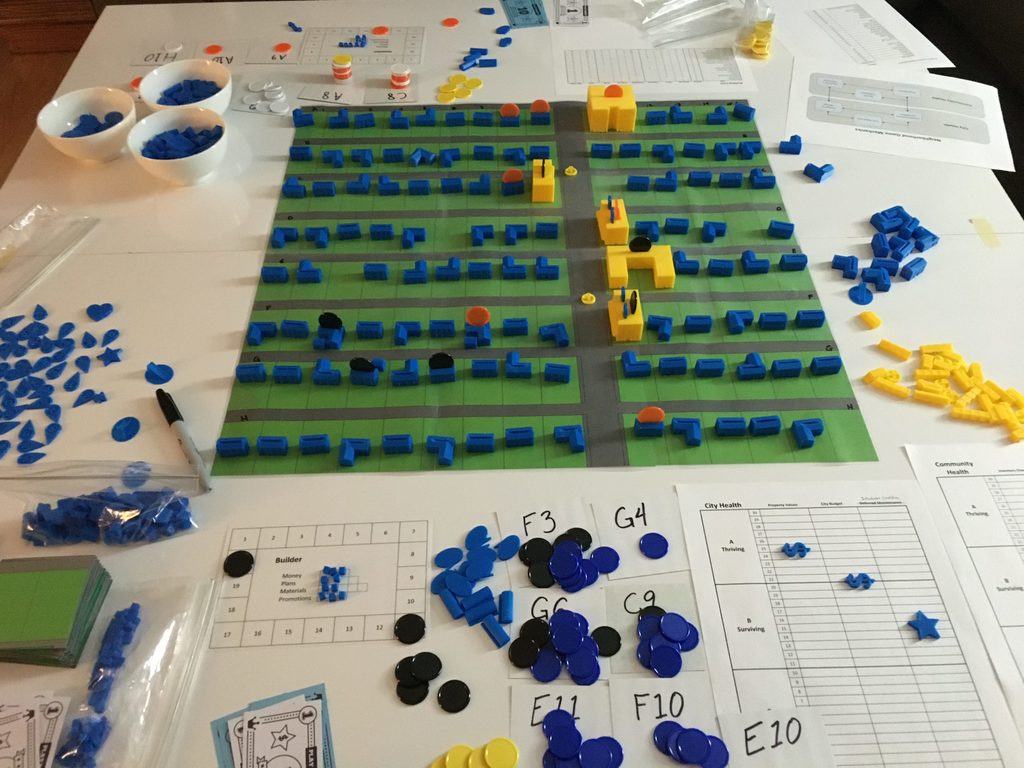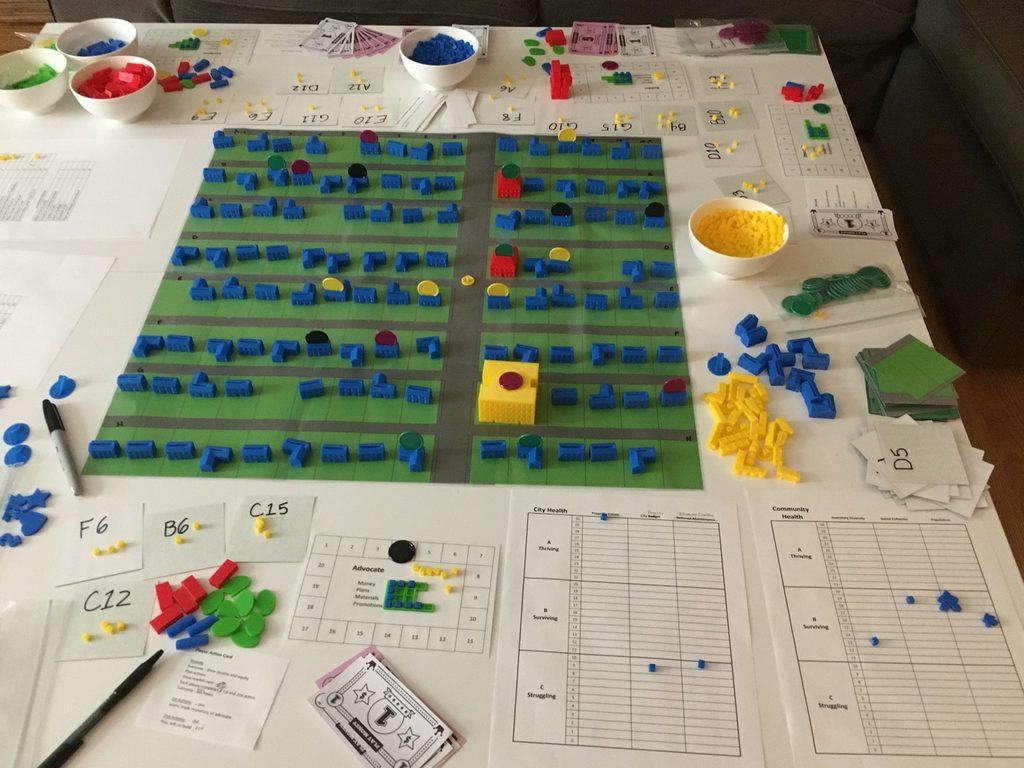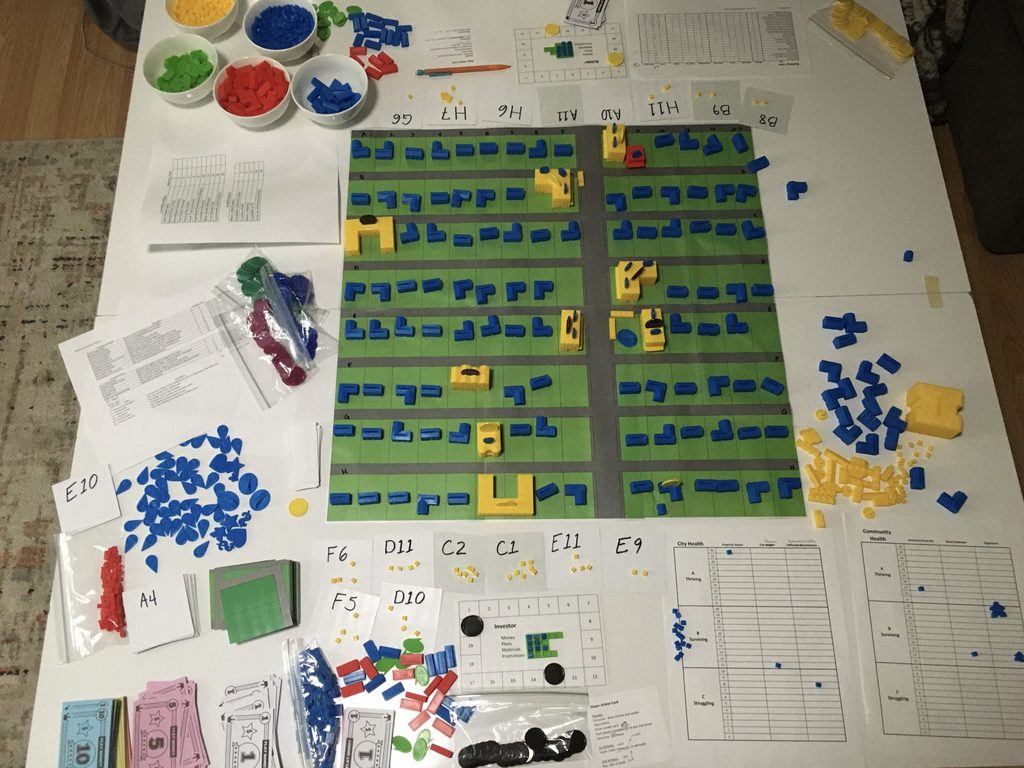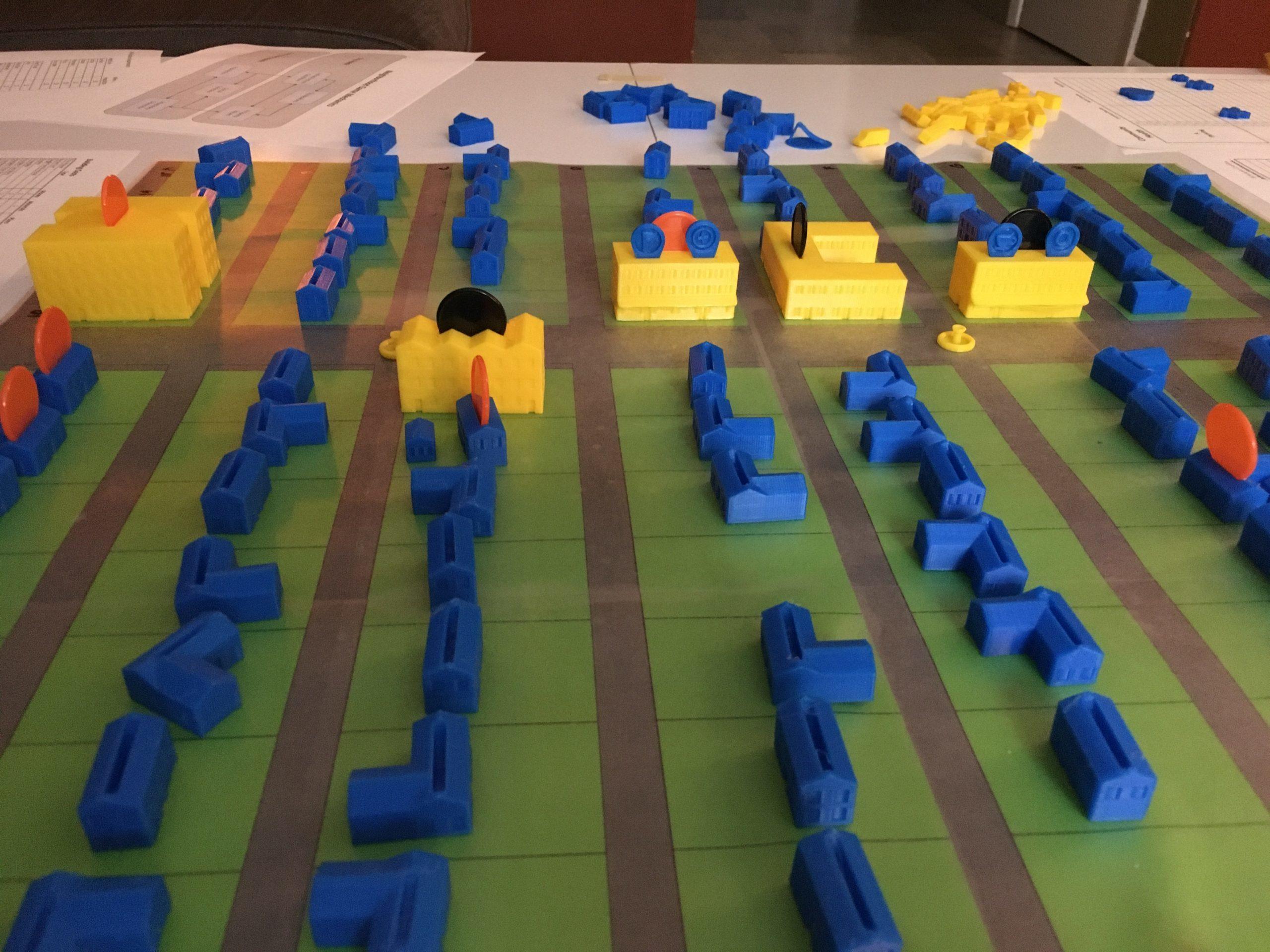I finished printing out a set of pieces, wrote some rules, and we finally began playtesting.
The goal of playtesting is to figure out what adjustments you need to make to make the game work better. See where the sticking points are. Figure out if the game is unbalanced for certain players or strategies. At some point, to do this rigorously enough you have to use spreadsheets or code.
For now, I just wanted to see if the rules made sense and how long it would take to play it. Did players need fewer or more options on a turn? Did the metrics make it possible to win or lose?
We have played 3 times now:
- Two players from the beginning.
- Four players from the beginning.
- Two players from the middle.
Each time, we spent about 3 hours playing and didn’t finish. The good news is that the metrics seem to be measuring the right things. We had good conversations about investment and city policies.
What we found though was that to play from the beginning to end might take 6-8 hours. After that, I sat down with Jerry Robinson on our board who has extensive experience with product development and playtesting. We can to the realization that keeping track of important elements including equity accumulation, taxes, and amenity clustering bonuses are going to require a companion app.
With that in mind, here are the end states of the 3 games we played and some discussion:
Game 1

To outline what you’re seeing:
- The blue pieces on the board are single-family residences. The yellow are live-work, mixed use, and multifamily.
- The black and orange chips indicate property ownership.
- On this board, the parcels are arranged in a grid with each street a letter. I made the mistake of not making the street and the alleys different sizes so we distinguish by the direction the houses are facing.
- The blue map pins (far left off the board) are for indicating retail uses. They go into the yellow buildings where there are slots for them.
- The yellow pieces to the right of the board are food trucks, farmers markets, and fountains that can double as roundabouts. We didn’t end up using the food trucks and farmers markets until the 3rd game.
- Left-below the board is the player card which tracks the player’s skills and income.
- Below the board are the property titles (i.e. F3, G4, etc.). The chips on them are equity that is added each turn. I ran out of black chips so I started using blue too.
- Between the player card and property titles are the resources. Aside from money (tracked with the paper money), we have plans, materials (for building), and outreach (aka promotions, advocacy, and comments). I realized after the first game that we can have blueprints for plans but the others should be different colors.
- To the right of the property titles are the scales. We have city health and community health.
- You win the game when all health scales get into the top tier (thriving).
- You lose the game when any health scale goes to zero.
- Not seen here are the policy descriptions you need to work together to pass to enable development, the policy tracker, and the building cost card.
What we learned from this game was that we jumped from single-family directly to 3-story buildings. It took forever to get policies passed and we stopped with less than half accomplished.
Game 2
We thought next it might go faster with more players so we invite a couple of friends over. What we found was that the “investor” player accumulated capital much faster than the rest of us. As the “advocate” player, I ended up trying to pass all the policies myself.
In the end, we couldn’t pass enough policies and we all ended up with a bunch of cash, nothing we could build, and nearly losing because we let the infrastructure degrade instead of investing in the community.

Some of the lessons from the second game:
- The investor was buying up all the best real estate on main street.
- I noticed that for the second time, we had players that jumped immediately to the 32-unit building. I’d added that as an over-building option but there was no penalty for doing that and huge financial upside.
- I also realized that I hadn’t printed all the pieces I meant to so some of the missing middle pieces are red because I ran out of yellow filament.
- While we almost lost because we let the infrastructure degrade, we did end up having to talk about what we would do to fix it. We all chipped in to do the “fix potholes” option which required us to spend advocacy resources and reduced the city reserves. If we’d played long enough we probably would have had to pass a bond to restore the city reserves.
- In the first game we didn’t use the scales to the full extent. In this game we did and it took a fair amount of extra time.
- We spent a lot of time discussing how many actions in which order players should be able to do. We also lost track of whose turn it was – we’d decided to issue resources and draw a market card all at once rather than one at a time.
- I realized that some people will need to play it through more than once just to understand the mechanics. One player kept telling the other that he wasn’t playing according to his real-life stated values by focusing on cash accumulation rather than investing in the community. It was fascinating and frustrating at the same time.
Game 3
We went back to two players to see how long it would take us to finish the game. We started in a state where all the policies had already been passed and only loosely used the scales. Mostly I was still trying to see if the population scale was moving appropriately with new development.

Lessons learned from game 3:
- We found that there was no straightforward way to calculate amenity clustering bonuses. That would be a premium on rent because you’re in the most walkable places.
- We still didn’t have a good way to differentiate taxes for different sized buildings.
- We did get a variety of buildings built but still skipped over most of the live-work types.
- We ran out of the 3-story corner mixed-use buildings. They seem to be the most bang for the buck on main street.
These last lessons were what Jerry and I discussed. We’re really going to have to develop an app to keep track of all the pieces. The next step then is to put everything that’s not on the board into the app.
Fortunately, I’m not starting from scratch. A few years back, I coded out the spreadsheet for UrbanPlan. That’s the real estate development simulation the Urban Land Institute does. I saw that students were getting stuck on the spreadsheet because ever time they changed something on the site, they would have to recalculate several things that could take 5-10 minutes. The feedback was delayed and disconnected.
For now, that’s what I’ll be focusing on with the game.

Leave a Reply